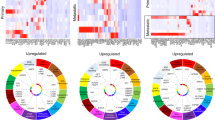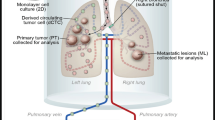Abstract
Bone metastasis of lung adenocarcinoma (AC) is a frequent complication of advanced disease. The purpose of this study was to identify key mediators conferring robust prometastatic activity with clinical significance. We isolated highly metastatic subpopulations (HMS) using a previously described in vivo model of lung AC bone metastasis. We performed transcriptomic profiling of HMS and stringent bioinformatics filtering. Functional validation was assessed by overexpression and lentiviral silencing of single, double and triple combination in vivo and in vitro. We identified HDAC4, PITX1 and ROBO1 that decreased bone metastatic ability after their simultaneous abrogation. These effects were solely linked to defects in osseous colonization. The molecular mechanisms related to bone colonization were mediated by non-cell autonomous effects that include the following: (1) a marked decrease in osteoclastogenic activity in vitro and in vivo, an effect associated with reduced pro-osteoclastogenic cytokines IL-11 and PTHrP expression levels, as well as decreased in vitro expression of stromal rankl in conditions mimicking tumor–stromal interactions; (2) an abrogated response to TGF-β signaling by decreased phosphorylation and levels of Smad2/3 in tumor cells and (3) an impaired metalloproteolytic activity in vitro. Interestingly, coexpression of HDAC4 and PITX1 conferred high prometastatic activity in vivo. Further, levels of both genes correlated with patients at higher risk of metastasis in a clinical lung AC data set and with a poorer clinical outcome. These findings provide functional and clinical evidence that this metastatic subset is an important determinant of osseous colonization. These data suggest novel therapeutic targets to effectively block lung AC bone metastasis.
This is a preview of subscription content, access via your institution
Access options
Subscribe to this journal
Receive 50 print issues and online access
$259.00 per year
only $5.18 per issue
Buy this article
- Purchase on Springer Link
- Instant access to full article PDF
Prices may be subject to local taxes which are calculated during checkout







Similar content being viewed by others
Abbreviations
- AC:
-
adenocarcinoma
- BLI:
-
bioluminescence imaging
- CM:
-
conditioned medium
- i.c.:
-
intracardiac
- i.t.:
-
intratibial
- KD:
-
knockdown
- MMP:
-
matrix metalloprotease
- SCDC:
-
single-cell-derived colonies
- TRAP:
-
Tartrate-resistant acid phosphatase
References
Feld R, Rubinstein LV, Weisenberger TH . Sites of recurrence in resected stage I non-small-cell lung cancer: a guide for future studies. J Clin Oncol 1984; 2: 1352–1358.
Fry WA, Menck HR, Winchester DP . The National Cancer Data Base report on lung cancer. Cancer 1996; 77: 1947–1955.
Goldstraw P, Ball D, Jett JR, Le Chevalier T, Lim E, Nicholson AG et al. Non-small-cell lung cancer. Lancet 2011; 378: 1727–1740.
Weilbaecher KN, Guise TA, McCauley LK . Cancer to bone: a fatal attraction. Nat Rev Cancer 2011; 11: 411–425.
Coleman RE . Skeletal complications of malignancy. Cancer 1997; 80: 1588–1594.
Nguyen DX, Massague J . Genetic determinants of cancer metastasis. Nat Rev Genet 2007; 8: 341–352.
Guise TA, Yin JJ, Taylor SD, Kumagai Y, Dallas M, Boyce BF et al. Evidence for a causal role of parathyroid hormone-related protein in the pathogenesis of human breast cancer-mediated osteolysis. J Clin Invest 1996; 98: 1544–1549.
Yin JJ, Selander K, Chirgwin JM, Dallas M, Grubbs BG, Wieser R et al. TGF-beta signaling blockade inhibits PTHrP secretion by breast cancer cells and bone metastases development. J Clin Invest 1999; 103: 197–206.
Vicent S, Luis-Ravelo D, Anton I, Garcia-Tunon I, Borras-Cuesta F, Dotor J et al. A novel lung cancer signature mediates metastatic bone colonization by a dual mechanism. Cancer Res 2008; 68: 2275–2285.
Valencia K, Ormazabal C, Zandueta C, Luis-Ravelo D, Anton I, Pajares MJ et al. Inhibition of Collagen Receptor Discoidin Domain Receptor-1 (DDR1) reduces cell survival, homing, and colonization in lung cancer bone metastasis. Clin Cancer Res 2012; 18: 969–980.
Antón I, Molina E, Luis-Ravelo D, Zandueta C, Valencia K, Ormazabal C et al. Receptor of activated protein c promotes metastasis and correlates with clinical outcome in lung adenocarcinoma. Am J Resp Crit Care Med 2012; 186: 96–105.
Nguyen DX, Chiang AC, Zhang XH, Kim JY, Kris MG, Ladanyi M et al. WNT/TCF signaling through LEF1 and HOXB9 mediates lung adenocarcinoma metastasis. Cell 2009; 138: 51–62.
Catena R, Luis-Ravelo D, Anton I, Zandueta C, Salazar-Colocho P, Larzabal L et al. PDGFR signaling blockade in marrow stroma impairs lung cancer bone metastasis. Cancer Res 2011; 71: 164–174.
Lu X, Wang Q, Hu G, Van Poznak C, Fleisher M, Reiss M et al. ADAMTS1 and MMP1 proteolytically engage EGF-like ligands in an osteolytic signaling cascade for bone metastasis. Genes Dev 2009; 23: 1882–1894.
Luis-Ravelo D, Anton I, Vicent S, Hernandez I, Valencia K, Zandueta C et al. Tumor-stromal interactions of the bone microenvironment: in vitro findings and potential in vivo relevance in metastatic lung cancer models. Clin Exp Metastasis 2011; 28: 779–791.
Shedden K, Taylor JM, Enkemann SA, Tsao MS, Yeatman TJ, Gerald WL et al. Gene expression-based survival prediction in lung adenocarcinoma: a multi-site, blinded validation study. Nat Med 2008; 14: 822–827.
Yasui T, Kadono Y, Nakamura M, Oshima Y, Matsumoto T, Masuda H et al. Regulation of RANKL-induced osteoclastogenesis by TGF-beta through molecular interaction between Smad3 and Traf6. J Bone Miner Res 2011; 26: 1447–1456.
Sapkota G, Knockaert M, Alarcon C, Montalvo E, Brivanlou AH, Massague J . Dephosphorylation of the linker regions of Smad1 and Smad2/3 by small C-terminal domain phosphatases has distinct outcomes for bone morphogenetic protein and transforming growth factor-beta pathways. J Biol Chem 2006; 281: 40412–40419.
Justilien V, Regala RP, Tseng IC, Walsh MP, Batra J, Radisky ES et al. Matrix metalloproteinase-10 is required for lung cancer stem cell maintenance, tumor initiation and metastatic potential. PLoS One 2012; 7: e35040.
Vega RB, Matsuda K, Oh J, Barbosa AC, Yang X, Meadows E et al. Histone deacetylase 4 controls chondrocyte hypertrophy during skeletogenesis. Cell 2004; 119: 555–566.
Backs J, Song K, Bezprozvannaya S, Chang S, Olson EN . CaM kinase II selectively signals to histone deacetylase 4 during cardiomyocyte hypertrophy. J Clin Invest 2006; 116: 1853–1864.
Wilson AJ, Byun DS, Nasser S, Murray LB, Ayyanar K, Arango D et al. HDAC4 promotes growth of colon cancer cells via repression of p21. Mol Biol Cell 2008; 19: 4062–4075.
Stronach EA, Alfraidi A, Rama N, Datler C, Studd JB, Agarwal R et al. HDAC4-regulated STAT1 activation mediates platinum resistance in ovarian cancer. Cancer Res 2011; 71: 4412–4422.
Reddy SD, Pakala SB, Molli PR, Sahni N, Karanam NK, Mudvari P et al. Metastasis-associated protein 1/histone deacetylase 4-nucleosome remodeling and deacetylase complex regulates phosphatase and tensin homolog gene expression and function. J Biol Chem 2012; 287: 27843–27850.
Marcil A, Dumontier E, Chamberland M, Camper SA, Drouin J . Pitx1 and Pitx2 are required for development of hindlimb buds. Development 2003; 130: 45–55.
Kolfschoten IG, van Leeuwen B, Berns K, Mullenders J, Beijersbergen RL, Bernards R et al. A genetic screen identifies PITX1 as a suppressor of RAS activity and tumorigenicity. Cell 2005; 121: 849–858.
Lord RV, Brabender J, Wickramasinghe K, DeMeester SR, Holscher A, Schneider PM et al. Increased CDX2 and decreased PITX1 homeobox gene expression in Barrett’s esophagus and Barrett’s-associated adenocarcinoma. Surgery 2005; 138: 924–931.
Chen Y, Knosel T, Ye F, Pacyna-Gengelbach M, Deutschmann N, Petersen I . Decreased PITX1 homeobox gene expression in human lung cancer. Lung Cancer 2007; 55: 287–294.
Rhee J, Mahfooz NS, Arregui C, Lilien J, Balsamo J, VanBerkum MF . Activation of the repulsive receptor Roundabout inhibits N-cadherin-mediated cell adhesion. Nat Cell Biol 2002; 4: 798–805.
Rhee J, Buchan T, Zukerberg L, Lilien J, Balsamo J . Cables links Robo-bound Abl kinase to N-cadherin-bound beta-catenin to mediate Slit-induced modulation of adhesion and transcription. Nat Cell Biol 2007; 9: 883–892.
Minn AJ, Gupta GP, Siegel PM, Bos PD, Shu W, Giri DD et al. Genes that mediate breast cancer metastasis to lung. Nature 2005; 436: 518–524.
Bos PD, Zhang XH, Nadal C, Shu W, Gomis RR, Nguyen DX et al. Genes that mediate breast cancer metastasis to the brain. Nature 2009; 459: 1005–1009.
Yang XM, Han HX, Sui F, Dai YM, Chen M, Geng JG . Slit-Robo signaling mediates lymphangiogenesis and promotes tumor lymphatic metastasis. Biochem Biophys Res Commun 2010; 396: 571–577.
Labbe E, Lock L, Letamendia A, Gorska AE, Gryfe R, Gallinger S et al. Transcriptional cooperation between the transforming growth factor-beta and Wnt pathways in mammary and intestinal tumorigenesis. Cancer Res 2007; 67: 75–84.
Kang Y, Siegel PM, Shu W, Drobnjak M, Kakonen SM, Cordon-Cardo C et al. A multigenic program mediating breast cancer metastasis to bone. Cancer Cell 2003; 3: 537–549.
Lecanda F . Tumor-stroma: tumor microenvironment as a target to combat metastasis. Dis Model Mech 2011; 8: 87–93.
Iguchi H, Onuma E, Sato K, Ogata E . Involvement of parathyroid hormone-related protein in experimental cachexia induced by a human lung cancer-derived cell line established from a bone metastasis specimen. Int J Cancer 2001; 94: 24–27.
Hernandez I, Moreno JL, Zandueta C, Montuenga L, Lecanda F . Novel alternatively spliced ADAM8 isoforms contribute to the aggressive bone metastatic phenotype of lung cancer. Oncogene 2010; 29: 3758–3769.
Acknowledgements
We are grateful to the Core Histology Unit and Imaging Group facilities for their outstanding technical assistance. We also thank the Proteomics, Genomics and Bioinformatics Unit at the CIMA. This work was supported by ‘UTE project FIMA’ agreement, The Cancer Research Thematic Network of the Health Institute Carlos III (RTICC RD06/0020/0066), PI042282, SAF-2009–11280, SAF2012-40056, grants 67/2005 and 09/2009 from the Government of Navarra, and ‘La Caixa Foundation’ to FL. DL-R was supported by the FIMA and FPU. IA was funded by the Basque Government. JDLR was supported by FIS-ISCIII grant PI12/00624. SV is an investigator of the Ramon y Cajal Program (MICINN, RYC-2011-09042).
Author information
Authors and Affiliations
Corresponding author
Ethics declarations
Competing interests
The authors declare no conflict of interest.
Additional information
Supplementary Information accompanies this paper on the Oncogene website
Supplementary information
Rights and permissions
About this article
Cite this article
Luis-Ravelo, D., Antón, I., Zandueta, C. et al. A gene signature of bone metastatic colonization sensitizes for tumor-induced osteolysis and predicts survival in lung cancer. Oncogene 33, 5090–5099 (2014). https://doi.org/10.1038/onc.2013.440
Received:
Revised:
Accepted:
Published:
Issue Date:
DOI: https://doi.org/10.1038/onc.2013.440
Keywords
This article is cited by
-
Bone metastases
Nature Reviews Disease Primers (2020)
-
Short-term starvation reduces IGF-1 levels to sensitize lung tumors to PD-1 immune checkpoint blockade
Nature Cancer (2020)
-
Tumor-derived exosomes promote the in vitro osteotropism of melanoma cells by activating the SDF-1/CXCR4/CXCR7 axis
Journal of Translational Medicine (2019)
-
Identification of differentially expressed genes regulated by molecular signature in breast cancer-associated fibroblasts by bioinformatics analysis
Archives of Gynecology and Obstetrics (2018)
-
Cancer-associated fibroblasts treated with cisplatin facilitates chemoresistance of lung adenocarcinoma through IL-11/IL-11R/STAT3 signaling pathway
Scientific Reports (2016)



